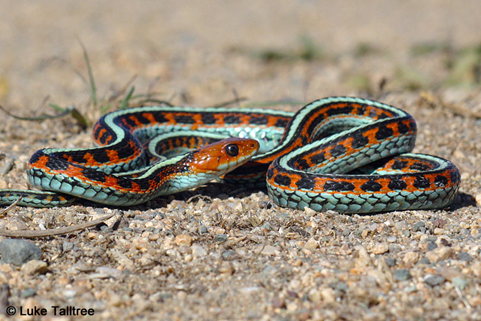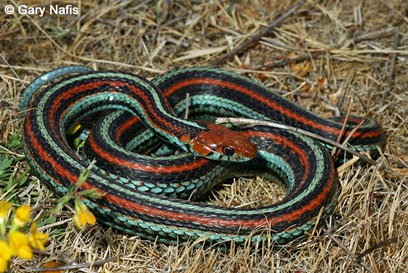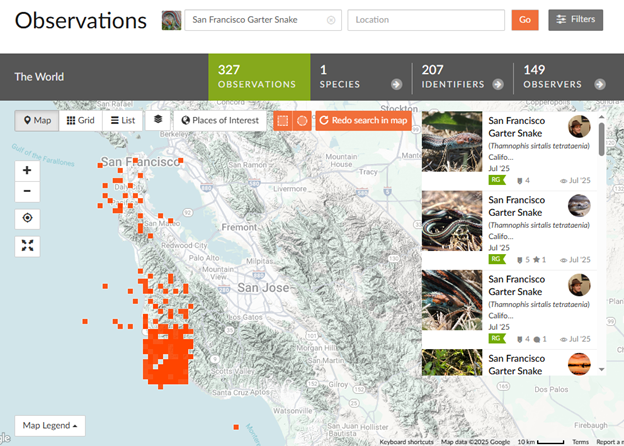Beauty and the Garter Snake: Local Subspecies & the Endangered San Francisco Garter Snake
By Ranger Rudy Montalvo, September 2025
California is home to a diverse range of snakes, boasting upwards of 50 different species! We're lucky to have 7 species of native Garter snakes native that can be further broken down into 10+ subspecies.
Here in the Tri-Valley area, we have some beautiful terrestrial and aquatic garter snakes: Coast Garter Snake (Thamnophis elegans terrestris), Diablo Range Garter Snake (Thamnophis atratus zaxanthus), and California Red-sided Garter Snake (Thamnophis sirtalis infernalis). If you see a garter snake that matches the description of the San Francisco garter snake in our open spaces, chances are you are seeing the California Red-sided Garter Snake, which can have similar striking coloration.


Brilliantly Colored San Francsico Garter Snake
For me, amongst the variety of snakes found here, one subspecies slithers out from the rest of them here in the Bay Area. The San Francisco garter snake is among California’s rarest snakes. It is a subspecies of the Common Garter Snake (Thamnophis sirtalis) with the scientific name Thamnophis sirtalis tetrataenia. While the Common garter snake, as its name suggests, is found throughout much of California and across North America, the San Francisco subspecies is historically only found in San Mateo County, the San Francisco Peninsula and parts of Santa Cruz County. It has very distinct and vibrant colors that seem to set it apart from the rest. The color patterns begin with either a bright orange or red head and a body of black and red stripes with a turquoise underbelly. Unfortunately, the beauty of this snake is one of the many reasons why it’s classified as endangered here in the Bay Area.
Endangered & Rarely Seen
Personally, I have yet to encounter a San Francisco garter snake but would love the opportunity to see one! This snake was officially designated as endangered on state lists in 1966 and later added to the first Federal Endangered Species List in 1973. The contributing factors that led to it becoming endangered include urbanization, the draining and pollution of wetlands, predators such as bullfrogs and largemouth bass, and as mentioned earlier the beauty of these snakes attracts illegal collectors. The areas where these snakes were most common and may still rarely be found are ponds, small marshes, canals, and other water sources.
Smelly Defense
The lifestyle of living in and spending their lives near water requires their diet to consist of Pacific tree frogs, California red-legged frogs, toads, immature newts, small fish, worms, and even small rodents. This snake doesn’t grow very long in terms of length, ranging from 39 to 47 inches. The males are smaller in length and weight than the females. Although this snake is non-venomous, when they feel threatened, they excrete foul smells from their anal glands and can often empty their bowels.
Local Habitat Hang Outs
The San Francisco garter snake requires both aquatic and upland habitat. They use grassy areas near water sources to regulate their body temperature, find cover, forage, mate, and hibernate. During the colder months, the snake moves into underground rodent burrows or under rocks for shelter. Today, the San Francisco garter gnake can be found in isolated populations and primarily along the coastline of San Mateo County. However, there have been rare sightings of them throughout the Bay Area near water sources.

Share Your Snake Sightings & Learn More!
Should you ever see one of these garter snake subspecies at Sycamore Grove Park, be sure to snap a picture and e-mail it to our ranger staff at natureprograms@larpd.org!
To learn more about our local snakes and meet one of the park’s animal ambassadors, come to my Snakes of Sycamore Grove program at the Ranger Station Picnic Area (5035 Arroyo Rd) on Saturday, September 13th at 1pm! Registration link: Snakes of Sycamore Grove
